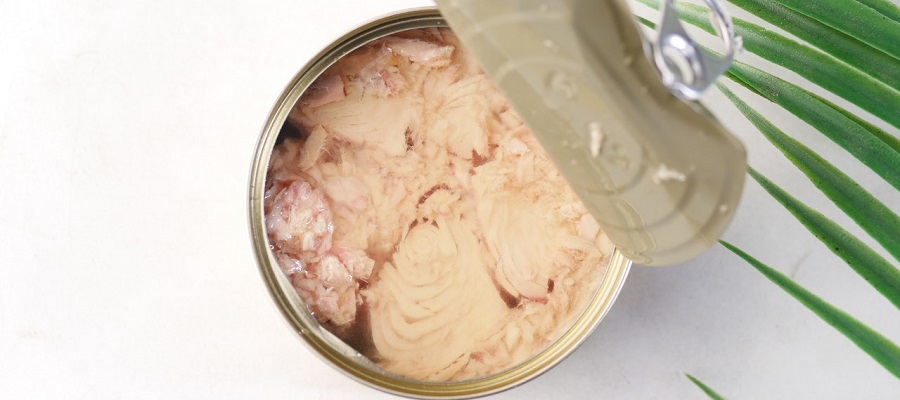Canned tuna is a popular and convenient source of protein that is often used in sandwiches, salads, and casseroles. It is typically made from chunks of tuna that are packed in oil or water and then sealed in a can. There are several types of canned tuna available, including white tuna, which is made from the meat of the albacore fish, and light tuna, which is made from the meat of smaller fish such as skipjack or yellowfin tuna.
Canned tuna is a good source of nutrients, including protein, omega-3 fatty acids, and various vitamins and minerals. However, it is also high in sodium and may contain mercury, so it should be consumed in moderation. Some brands of canned tuna are more sustainable than others, so it is important to research and choose a brand that uses sustainable fishing practices.
There are many ways to use canned tuna in cooking. It can be mixed with mayonnaise and used as a filling for sandwiches or mixed with vegetables and served as a salad. Canned tuna can also be used in casseroles, pasta dishes, and sushi rolls. It is important to drain the tuna well before using it in a recipe to reduce the amount of oil or water it contains.
In summary, canned tuna is a convenient and nutritious food that can be used in a variety of recipes. However, it is important to choose a sustainable brand and to consume it in moderation due to its high sodium content and potential mercury levels.
sustainable canned tuna brands
Here are a few brands of canned tuna that are known for their sustainable fishing practices:
- Wild Planet
- American Tuna
- Safe Catch
- Chicken of the Sea (specifically their "Sustainable Select" line)
- Ocean Safe Tuna
- Pole & Line
It is important to note that while these brands have implemented sustainability measures, there is always room for improvement and it is a good idea to do your own research and choose a brand that aligns with your values. You can also look for certifications such as the Marine Stewardship Council's blue ecolabel, which indicates that a product has been sustainably caught.
Does tuna contain a large amount of sodium?
Canned tuna does contain a significant amount of sodium, as it is often packed in brine (a mixture of water and salt) to help preserve it. The exact amount of sodium in canned tuna can vary depending on the brand and the specific product, but a 3-ounce serving of canned tuna packed in brine can contain up to 300 milligrams of sodium. This is about 20% of the recommended daily maximum intake of sodium for adults.
It is important to be aware of the sodium content of the foods you eat, especially if you are following a low sodium diet or have been advised by a healthcare professional to limit your sodium intake. If you are trying to reduce your sodium intake, you can choose low sodium options or "no salt added" canned tuna, and rinse the tuna well before using it in a recipe to help reduce the sodium content.
low sodium canned tuna options
Here are a few brands of canned tuna that offer low sodium options:
- Wild Planet
- Safe Catch
- Chicken of the Sea (specifically their "Sustainable Select" line)
- Ocean Safe Tuna
- Pole & Line
It is important to read the nutrition labels and ingredient lists of the products you are considering to ensure that you are choosing a low sodium option. Some brands may also offer "no salt added" options, which can be a good choice for those who need to limit their sodium intake. It is also a good idea to rinse canned tuna before using it in a recipe to help reduce the sodium content.
Is there an alternative fish for tuna?
There are many types of fish that can be used as alternatives to tuna in recipes. Some options to consider include:
-
Salmon: This is a flavorful and versatile fish that can be used in many of the same ways as tuna.
-
Mackerel: This is a flaky and flavorful fish that is similar in taste to tuna and can be used in a variety of dishes.
-
Sardines: These small, oily fish have a strong flavor and are often used in Mediterranean and Portuguese cuisine.
-
Anchovies: These small, salty fish have a strong flavor and are often used in Italian and Mediterranean cuisine.
-
Herring: This is a flavorful and oily fish that is similar in taste to tuna and can be used in many of the same ways.
Each of these fish has its own unique flavor and texture, so you may need to experiment to find the one that best fits your tastes and the recipe you are using.
Is mercury in tuna harmful?
Mercury is a toxic metal that can be harmful to human health if consumed in large amounts. It is found in some types of fish, including tuna, and can accumulate in the bodies of these fish as they feed on smaller organisms.
The amount of mercury in tuna can vary depending on the type of tuna and the specific product. Generally, larger, predatory fish tend to have higher levels of mercury because they have had more time to accumulate it from their diet. Light tuna, which is made from smaller fish such as skipjack or yellowfin tuna, tends to have lower levels of mercury than white tuna, which is made from albacore.
It is important to be aware of the mercury content of the fish you consume and to follow the guidelines for safe consumption set by organizations such as the US Food and Drug Administration (FDA). The FDA recommends that adults and children over the age of 6 can safely eat up to 12 ounces (2 average meals) of a variety of fish per week. Pregnant women, nursing mothers, and young children should avoid some types of fish altogether and limit their consumption of other types of fish to avoid exposing themselves to high levels of mercury.
canned tuna with the least mercury
It is important to note that all types of tuna, including canned tuna, can contain some level of mercury. Mercury is a toxic metal that can accumulate in the bodies of fish as they feed on smaller organisms, and it can be harmful to humans if consumed in large amounts. Larger, predatory fish tend to have higher levels of mercury because they have had more time to accumulate it from their diet.
That being said, there are some steps you can take to choose canned tuna with lower levels of mercury:
-
Choose light tuna instead of white tuna: Light tuna is typically made from smaller fish such as skipjack or yellowfin tuna, which tend to have lower levels of mercury. White tuna, on the other hand, is made from albacore, which tends to have higher levels of mercury.
-
Choose tuna that is pole-and-line caught or troll-caught: These methods of fishing have a lower impact on the environment and tend to result in lower levels of mercury in the tuna.
-
Check the labels and choose brands that are certified by organizations such as the Marine Stewardship Council (MSC) or the Environmental Defense Fund (EDF). These certifications indicate that the tuna has been sustainably caught and is of a high quality.
It is also a good idea to consume tuna in moderation and to follow the guidelines for safe consumption set by organizations such as the US Food and Drug Administration (FDA).


